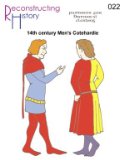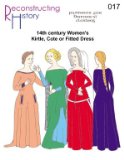|
All particolored garments depicted in medieval illustrations and artwork seem to be set up so that all parts of the right side of the body are one color, and all parts on the left are the other. Sleeves are the same color as the section of the body to which they are attached.
Men’s hose may be the same, counterchanged, or completely different from the color worn on that side of the body.
Often, particolored garments seem to be worn by musicians, jesters, or liveried servants, but particolored garments appear in other contexts as well. (Another term used for particolor on some of these webpages is “mi-parti,” though this term can apply to other styles of multicolored cloth or clothing as well.)
- Male musicians playing the vielle in illustrations of the daughters of Shiloh (fol. 17r) and the women of Israel (fol. 29r) from the Maciejowski Bible (PML M.638), 1240s
- The Söderköping Tunic, before 1242
See webpages by Marienna or Diarmaid for information about this extant garment.
- Man holding the reins of three horses, fresco at Tour Ferrande, c. 1265
- The Rønbjerg Tunic, ca. 1280
See webpages by Marienna or Diarmaid for information about this extant (and hypothetically particolored) garment.
- The Konstanz-Weingartner Liederhandschrift (HB XIII 1), 1290-1320, shows particolored garments in the illustrations of Friedrich von Hausen, Heinrich von Veldeke, Ulrich von Munegiur, Ulrich von Singenberg, and Herre Rubin.
- A servant in Supper in the House of the Pharisee by Giotto, early 14th century
- Torturers in a wall painting from a church in England, early 14th century
- Servant-women in profane love scenes of bathing and spouses retired to bed by Memmo di Filippuccio, c. 1306
- A young man in the illustration of Der junge Meißner from the Manesse Codex (UBH Cod. Pal. germ. 848, fol. 339r), 1300-1330
- Falconer, servant (?), and musicians in the Knighting of St. Martin from the Scenes from the Life of St. Martin (Cappella di San Martino, Lower Church of San Francesco, Assisi) by Simone Martini, 1312-1317
- Nobles at a fountain, Cocharelli Treatise on the Vices (British Library Egerton 3781, verso), c. 1314-1324
- Liveried servers (?) at right in the Feast of Herod from the frescoes in the Peruzzi Chapel (Florence) by Giotto di Bondone, 1320
- Scourging of Christ (fol. 92v), The Luttrell Psalter (British Library Add. 42130), c. 1325-1335
- Men wearing particolored tunics in an edition of Brunetto Latini’s Book of the Treasure (BNF Fr 571, fol. 66v), ca. 1326
- Dancing girl in the Fresco of the Good Government (Palazzo Publico, Siena) by Ambrogio Lorenzetti, 1338-1340
- Many figures in several illustrations from the Romance of Alexander (Bodley 264), c. 1338-44, including illustrations on pages 40r and 124r
- The Bride Abandoned by Nicolo da Bologna, 1350s
- Various examples of particolored Spanish garments with plaid (on the bias) on the left side (all ca. 1360 or thereabouts) can be found at The Ever-Elusive Plaid Cotehardie
And mooreover, the wrecched swollen membres that they shewe thurgh disgisynge, in departynge of hire hoses in whit and reed, semeth that half hir shameful privee membres weren flayne. And if so be that they departen hire hoses in othere colours, as is whit and blak, or whit and blew, or blak and reed, and so forth, thanne semeth it, as by variaunce of colour, that half the partie of hire privee membres were corrupt by the fir of Seint Antony, or by cancre, or by oother swich meschaunce. The Parson's Tale (on the sin of pride), The Canterbury Tales - Dancers and observers from The Church Militant and Triumphant (Cappella Spagnuolo, Santa Maria Novella, Florence) by Andrea da Firenze, 1365-1368
- Harry the Hayward, a calendar (Rawl. D. 939, section 1r), late 14th century
- A jailer in the wall painting of the life of St. Catherine at St. Mary's Church in Sporle, Norfolk, England, 1390-1400
- A woman in a wall-painting at Jungshoved church, in Denmark, c. 1400
- The allegory of Fortune in a wall-painting at Udby church, in Denmark, c. 1400 (note that her particolored gown is probably part of the allegorical imagery, demonstrating good fortune and ill fortune, as seen in another depiction of Fortune, from De casibus, BNF Fr. 229, fol. 221)
- A man in a particolored gown, book of hours (Douce 62, fol. 43r), c. 1400
- A young man in the July fresco at the Castello Buonconsiglio, c. 1405-1410
- A pistachio-harvest and quail hunt in the Tacuinum Sanitatis, 15th century (BNF Nouvelle acquisition latine 1673)
- Server in January illustration from the Tres Riches Heures du Duc de Berry, 1412-1416. There are also two servants in mirror-image brown and orange livery at far left (pouring wine from a flagon into a mazer) and far right (feeding a dog).
- A sybil in a wall-painting at Kvislemark church in Denmark, c. 1425-1450
- Servers in an illustration from the Chroniques d'Alexandre
- A young page attending a nobleman visiting a goldsmith's shop in Livre des simples médecines (BNF Fr. 9136, fol. 344), 15th century
- A man standing before a crowned woman enthroned and two women in conversation (Getty Ms. Ludwig XV 1, fol. 39v), third quarter of the 15th century
- A shepherd, Life of St. Barbara, c. 1470 (The Hague, KB, 133 B 13 fol. 55r)
- A man and his wife are hanged, Der Renner (PML M.763, fol. 107v), last quarter of the 15th century
- Mural with dancers and the prince-electors (details 1, 2, and 3), at Zvikov, c. 1480-1500
- Musicians play for dancers as St. Vitus renounces worldly pleasures in an altarpiece from Innsbruck, c. 1510-1520
- Luzerner Schilling chronicle, 1513
- Squires at a tournament in June in the Hennessy Book of Hours, c. 1530-1540
Many thanks to Camilla Luise Dahl for her suggestions on Danish church paintings!
|





